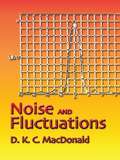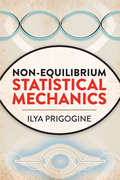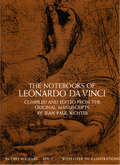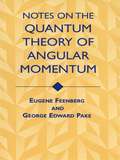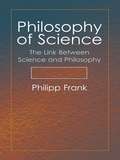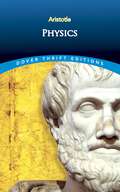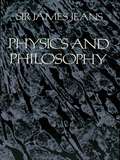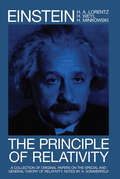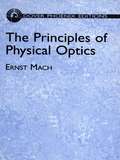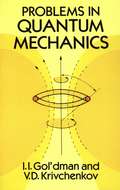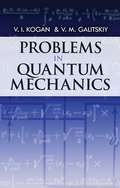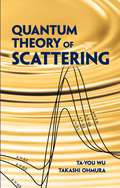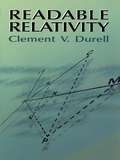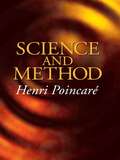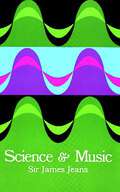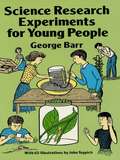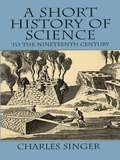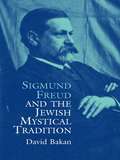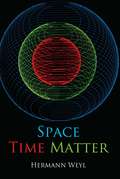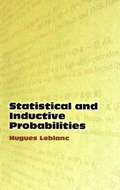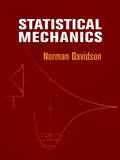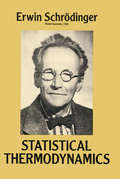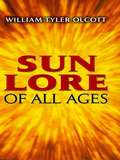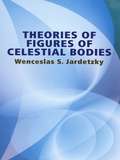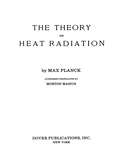- Table View
- List View
Noise and Fluctuations: An Introduction
by D. K. MacDonaldAn understanding of fluctuations and their role is both useful and fundamental to the study of physics. This concise study of random processes offers graduate students and research physicists a survey that encompasses both the relationship of Brownian Movement with statistical mechanics and the problem of irreversible processes. It outlines the basics of the physics involved, without the strictures of mathematical rigor.The three-part treatment starts with a general survey of Brownian Movement, including electrical Brownian Movement and "shot-noise," Part two explores correlation, frequency spectrum, and distribution function, with particular focus on application to Brownian Movement. The final section examines noise in electric currents, including noise in vacuum tubes and a random rectangular current. Frequent footnotes amplify the text, along with an extensive selection of Appendixes.
Non-Equilibrium Statistical Mechanics (Dover Books On Physics Series)
by Ilya PrigogineIlya Prigogine won the 1977 Nobel Prize in Chemistry for his contributions to non-equilibrium thermodynamics. This groundbreaking 1962 monograph, written for researchers and graduate students in this field, was his first book-length contribution to this subject. Suitable for advanced undergraduates and graduate students in physics and chemistry, the treatment begins with examinations of the Liouville equation, anharmonic solids, and Brownian motion. Subsequent chapters explore weakly coupled gases, scattering theory and short-range forces, distribution functions and their diagrammatic representation, the time dependence of diagrams, the approach to equilibrium in ionized gases, and statistical hydrodynamics. Additional topics include general kinetic equations, general H-theorem, quantum mechanics, and irreversibility and invariants of motion. Appendices, a bibliography, list of symbols, and an index conclude the text.
The Notebooks of Leonardo da Vinci, Vol. 1 (Dover Fine Art, History of Art #1)
by Leonardo Da VinciScientist, painter, mechanical engineer, sculptor, thinker, city planner, storyteller, musician, architect — Leonardo da Vinci, builder of the first flying machine, was one of the great universal geniuses of Western civilization. His voluminous notebooks, the great storehouse of his theories and discoveries, are presented here in 1566 extracts that reveal the full range of Leonardo's versatile interest: all the important writings on painting, sculpture, architecture, anatomy, astronomy, geography, topography, and other fields are included, in both Italian and English, with 186 plates of manuscript pages and many other drawings reproduced in facsimile size.The first volume, which contains all of Leonardo's writings on aspects of painting, includes discussions of such basic scientific areas as the structure of the eye and vision, perspective, the science of light and shade, the perspective of disappearance, theory of color, perspective of color, proportions and movements of the human figure, botany for painters, and the elements of landscape painting. A section on the practice of painting includes moral precepts for painters and writings on composition, materials, and the philosophy of art. The second volume contains writings on sculpture, architecture (plans for towns, streets, and canals, churches, palaces, castles, and villas, theoretical writings on arches, domes, fissures, etc.), zoology, physiology (including his amazingly accurate theories of blood circulation), medicine, astronomy, geography (including has famous writings and drawings on the movement of water), topography (observations in Italy, France, and other areas), naval warfare, swimming, theory of flying machines, mining, music, and other topics.A selection of philosophical maxims, morals, polemics, fables, jests, studies in the lives and habits of animals, tales, and prophecies display Leonardo's abilities as a writer and scholar. The second volume also contains some letters, personal records, inventories, and accounts, and concludes with Leonardo's will. The drawings include sketches and studies for some of Leonardo's greatest works of art — The Last Supper, the lost Battle of Anghiari, The Virgin of the Rocks, and the destroyed Sforza monument.
Notes on the Quantum Theory of Angular Momentum
by Eugene Feenberg George Edward PakeThis classic, concise text has served a generation of physicists as an exceptionally useful guide to the mysteries of angular momenta and Clebsch-Gordon Coefficients. Derived from notes originally prepared to assist graduate students in reading research papers on atomic, molecular, and nuclear structure, the text first reviews the basic elements of quantum theory. It then examines the development of the fundamental commutation relations for angular momentum components and vector operators, and the ways in which matrix elements and eigenvalues of the angular momentum operators are worked out from the commutation relations.These chapters constitute a review on an elementary level of material usually included in a one-year course in quantum theory. In the second half of the text, the matrix elements of scalar, vector, and tensor operators are computed and applied to derive several useful relations in the theory of magnetic moments, electric quadruple moments, and dipole transition probabilities. Eschewing all that is irrelevant, this book focuses on the essentials and prepares readers for further study in the field. A helpful list of references concludes the work.
Philosophy of Science: The Link Between Science and Philosophy
by Philipp FrankA great mathematician and teacher bridges the gap between science and the humanities in this exposition of the philosophy of science. Philipp Frank, a distinguished physicist and philosopher in his own right, traces the history of science from Aristotle to Einstein to illustrate philosophy’s ongoing role in the scientific process.Suitable for undergraduate students and other readers, this volume explains modern technology’s role in the gradual erosion of the rapport between physical theories and philosophical systems, and offers suggestions for restoring the link between these related areas. Dr. Frank examines the ancient Greek concept of natural science to illustrate the development of modern science; then, using geometry as an example, he charts its progress from Euclidean principles through the interpretations of Descartes, Mill, Kant, and the rise of four-dimensional and non-Euclidean geometry. Additional topics include the laws of motion, before and after innovations of Galileo and Newton; perceptions of motion, light, and relativity through the ages; metaphysical interpretations of relativistic physics; the motion of atomic objects and the phenomena and formulations of atomic physics; and the principle of causality and the validation of theories.
Physics (Dover Thrift Editions #Vol. 2)
by AristotleWritten in the fourth century BCE by Greek philosopher and scientist Aristotle, Physics set out to define the principles and causes of change, movement, and motion. For 2,000 years ― until discoveries by Galileo, Newton, and other scientists ― this treatise was the primary source for explanations of falling rocks, rising flames, the circulation of air, and other physical phenomena. Modern readers are required to bring a keen sense of criticism to these writings. Although Aristotle incorporated some degree of experience and observation in his thinking, the root of his reasoning lies in the philosophical approach. The brilliance of the philosopher's mind and his articulate manner of expression, together with the fact that he was among the first to undertake an intellectually rigorous investigation of nature's basic properties, contribute to the historic value of this book. It remains a foundational work of modern science and philosophy and a key to understanding the work of subsequent theorists and scholars.
Physics and Philosophy
by James JeansCan we have any knowledge of the world outside us other than we gain by the methods of science? Are we humans endowed with free will, or are we mere cogs in a vast machine that must follow its predestined course until it finally runs down? Is the world we perceive the world of ultimate reality, or is it only a curtain veiling a deeper reality beyond?In this strikingly lucid and often poetic book, one of the twentieth century's greatest scientists grapples with these age-old questions, achieving in the process a brilliant and non-technical exposition of the interrelationship between physics and philosophy. He begins by defining physics and philosophy, pointing out the difference in their respective attempts to explain physical reality and man's place in it. This discussion paves the way for an outline of epistemological methods in which the rationalism of thinkers like Descartes, Leibniz, and Kant is compared to the empiricism of Locke and Hume.Over the course of the book, in a manner that is careful and methodic but never dull, Jeans marshals the evidence for his startling conclusion: recent discoveries in astronomy, mathematics, sub-atomic physics, and other disciplines have washed away the scientific basis of many older philosophic discussions. Such long-standing problems as causality, free will and determinism, the nature of space and time, materialism and mentalism must be considered anew in the light of new knowledge and information attained by twentieth-century physical science. Even then, however, Jeans cautions against drawing any positive conclusions, pointing out that both physics and philosophy are both relatively young and that we are still in Newton's words, like children playing with pebbles on the sea-shore, while the great ocean of truth rolls, unexplored, beyond our reach.Although first published in 1943, nothing in physics has happened to affect Jeans's account in this book; it remains remarkably fresh and undated, a classic exposition of the philosophical implications of scientific knowledge.
The Principle of Relativity
by Albert Einstein Francis A. DavisThis collection of original papers on the special and general theories of relativity is an unabridged translation of the 4th edition of Das Relativitatsprinzip, together with a revised edition of an additional paper by H. A. Lorentz.CONTENTS: I. "Michelson's Interference Experiment" by H. A . Lorentz. II. "Electromagnetic Phenomena in a System Moving with any Velocity Less than that of Light" by H. A . Lorentz. Ill. "On the Electrodynamics of Moving Bodies" by A. Einstein. IV. "Does the Inertia of a Body Depend Upon its Energy-Content?" by A. Einstein. V. "Space and Time" by H. Minkowski. VI. "On the Influence of Gravitation on the Propagation of Light" by A. Einstein. VII. "The Foundation of the General Theory of Relativity" by A. Einstein. VIII. "Hamilton's Principle and the General Theory of Relativity" by A. Einstein. IX. "Cosmological Considerations on the General Theory of Relativity" by A. Einstein. X. "Do Gravitational Fields Play an Essential Part in the Structure of the Elementary Particles of Matter?" by A. Einstein. XI. "Gravitation and Electricity" by H. Weyl."The book constitutes an indispensable part of a library on relativity," Nature. "It is really a thrill to read again the original papers by these giants," School Science and Mathematics. "Warmly recommended," Quarterly of Applied Mathematics.
The Principles of Physical Optics: An Historical and Philosophical Treatment
by Ernst MachIn this classic exposition, Ernst Mach presents a detailed account of the experimental and theoretical evolution of our understanding of light phenomena and apparatus. Beginning with the philosophic and physiological speculation arising from early experiments on light and color perception, he proceeds to a thorough examination of the history of diopterics, including the roles of Huyghens, Galileo, Descartes, the Bernoullis, Kepler, and other scientists.Full descriptions of hundreds of experiments and detailed treatments of theory cover Newton's work with color and dispersion, his concept of the periodicity of light, the development of the theory of interference, and the perfection and elaboration of these ideas up until the mid-nineteenth century. A survey of polarization ranges from Bartholinus's paper on double refracting Iceland spar through work by Malus, Brewster, Biot, Arago, to the definitive work of Young and Fresnel. The final third of the book considers the mathematical representation of the properties of light; refinements in the theory of linear, circular, and elliptic polarization; and advanced diffraction experiments, including the theory of the diffraction grating.Students, teachers, and historians of science as well as physicists, engineers, designers of optical systems, and all readers interested in the development and perfection of scientific research will find this volume a stimulating and informative resource.
Problems in Quantum Mechanics
by V. D. Krivchenkov I. I. Gol’dmanA comprehensive collection of problems of varying degrees of difficulty in nonrelativistic quantum mechanics, with answers and completely worked-out solutions. Among the topics: one-dimensional motion, transmission through a potential barrier, commutation relations, angular momentum and spin, and motion of a particle in a magnetic field. An ideal adjunct to any textbook in quantum mechanics, useful in courses in atomic and nuclear physics, mathematical methods in physics, quantum statistics and applied differential equations. 1961 edition.
Problems in Quantum Mechanics
by V. I. Kogan Harold Gersch V. M. GalitskiyWritten by a pair of distinguished Soviet mathematicians, this compilation presents 160 lucidly expressed problems in nonrelativistic quantum mechanics plus completely worked-out solutions. Some were drawn from the authors' courses at the Moscow Institute of Engineering, but most were prepared especially for this book. A high-level supplement rather than a primary text, it constitutes a masterful complement to advanced undergraduate and graduate texts and courses in quantum mechanics.The mathematics employed in the proofs of the problems--asymptotic expansions of functions, Green's functions, use of different representation spaces, and simple limiting cases--are detailed and comprehensive. Virtually no space is devoted to the physical statements underlying the problems, since this is usually covered in books on quantum mechanics. Teachers and students will find this volume particularly valuable in terms of its advanced mathematics and detailed presentations, its coverage of scattering theory, and its helpful graphs and explanatory figures.
Quantum Theory of Scattering
by Takashi Ohmura Ta-You WuThis volume addresses the broad formal aspects and applications of the quantum theory of scattering in atomic and nuclear collisions. An encyclopedic source of pioneering work, it serves as a text for students and a reference for professionals in the fields of chemistry, physics, and astrophysics. The self-contained treatment begins with the general theory of scattering of a particle by a central field. Subsequent chapters explore particle scattering by a non-central field, collisions between composite particles, the time-dependent theory of scattering, and nuclear reactions. An examination of dispersion relations concludes the text. Numerous graphs, tables, and footnotes illuminate each chapter, in addition to helpful appendixes and bibliographies.
Readable Relativity
by Clement V. DurellConcise and practical, this text by a renowned teacher sketches the mathematical background essential to understanding the fundamentals of relativity theory. Subjects include the velocity of light, measurement of time and distance, and properties of mass and momentum, with numerous diagrams, formulas, and examples, plus exercises and solutions. 1960 edition.
Science and Method
by Henri PoincaréThis classic by the famous mathematician defines the basic methodology and psychology of scientific discovery, particularly regarding mathematics and mathematical physics. Drawing on examples from many fields, it explains how scientists analyze and choose their working facts, and it explores the nature of experimentation, theory, and the mind. 1914 edition.
Science and Music (Dover Books On Music Ser.)
by James JeansSir James Jeans, noted British scientist, has given a physical analysis of musical sounds, in what is considered to be the best exposition on the subject, a book of great intellectual stature. His aim has been to convey precise information, in a simple non-technical way, that will be of interest to the amateur as well as the serious student of music. The discussion begins with an explanation of the development of the human faculty of hearing. It is established that each sound can be represented by a curve. An examination of the general properties of sound-curves follows. For example, why do some sounds produce pleasure when they reach our ears and some pain? How do we retain the pleasurable qualities in the sound-curve, as it passes on from one stage of electronic equipment to another? To what extent is it possible to prevent unpleasant qualities from contaminating the curve? These and other pertinent questions on the transmission and reproduction of sound-curves are answered in a discussion of tuning-forks and pure tones. The various methods of producing sound, and the qualities of the sounds produced, are further discussed as they relate to vibrations of strings and harmonics, and vibrations of air. Harmony and discord are also considered. In the final chapters on the concert room and hearing, the discussion focuses on the transmission of sound from its source to the eardrum and from the eardrum to the brain. A general theory of acoustics is also covered as well as acoustical analyses.
Science Research Experiments for Young People
by George BarrIntriguing, abundantly illustrated collection of 40 experiments to attract and stimulate young minds. Subjects range from electricity and magnetism to weather, water, distance and time. Among the projects: flight testing homemade rocket balloons and tracking electricity around the house.
A Short History of Science to the Nineteenth Century
by Charles SingerDriven by an unquenchable thirst, the human spirit seeks an explanation of the world. In this fascinating study, a noted historian of science traces the course of the ceaseless yearning for answers across two and a half millennia and chronicles, in simple form, the development of the idea of a rational and interconnected material world. This account begins with the earliest recordings of true science among the Ionian Greeks and proceeds to detail the development of unitary systems of thought among Plato, Aristotle, the Stoics, and others. Examinations of the science of imperial Rome ― including Roman mathematics, astronomy, physics, and calendarial science ― give rise to the science of the Middle Ages and the influence of Scholasticism, the rise of humanism, and the reawakened scientific spirit of the early Renaissance. These developments in turn led to the downfall of Aristotelian science in the seventeenth century, the Galilean revolution, Newtonian mathematical physics, and finally, the enthronement of determinism in the eighteenth and nineteenth centuries. Profusely illustrated with maps and diagrams, this comprehensive yet concise volume offers an absorbing, readable history of science up to the dawn of the modern era.
Sigmund Freud and the Jewish Mystical Tradition
by David BakanIn this pioneering work, David Bakan challenges the popular view of Freud as an entirely secular intellectual, schooled in modern culture rather than Jewish traditions. Bakan contends that the father of psychology was profoundly influenced by mystic lore about which he appeared to know very little -- and which represents the antithesis of scientific method.This work is based on the premise that Freudian psychoanalytic theory is largely rooted in the Jewish religion, particularly the mysticism of the kabbala. In a fascinating interpretation of the blend of personality and cultural history, Bakan explains how Freud's Jewish heritage contributed, either consciously or unconsciously, to his psychological theories. The author employs Freud's own distinction between being a Jew and the acceptance of Jewish doctrine to demonstrate the effect of Jewish mysticism in the formation of Freud's technical genius.With its focus on the ways in which Freud was and was not Jewish, this study offers a model example of the problem of Jewish identity -- as embodied by one of the giants of modern science, who professed to be both "infidel" and "Jew."
Space, Time, Matter (Dover Books On Physics Series)
by Hermann WeylReflecting the revolution in scientific and philosophic thought which accompanied the Einstein relativity theories, Dr. Weyl has probed deeply into the notions of space, time, and matter. A rigorous examination of the state of our knowledge of the world following these developments is undertaken with this guiding principle: that although further scientific thought may take us far beyond our present conception of the world, we may never again return to the previous narrow and restricted scheme.Although a degree of mathematical sophistication is presupposed, Dr. Weyl develops all the tensor calculus necessary to his exposition. He then proceeds to an analysis of the concept of Euclidean space and the spatial conceptions of Riemann. From this the nature of the amalgamation of space and time is derived. This leads to an exposition and examination of Einstein's general theory of relativity and the concomitant theory of gravitation. A detailed investigation follows devoted to gravitational waves, a rigorous solution of the problem of one body, laws of conservation, and the energy of gravitation. Dr. Weyl's introduction of the concept of tensor-density as a magnitude of quantity (contrasted with tensors which are considered to be magnitudes of intensity) is a major step toward a clearer understanding of the relationships among space, time, and matter.
Statistical and Inductive Probabilities (Dover Books on Mathematics)
by Hugues LeblancAmong probability theorists, a bitter controversy has raged for decades between the adherents of John Maynard Keynes' A Treatise on Probability (1921) and those of Richard von Mises' "Grundlagen der Wahrscheinlichkeitsrechnung" (1919). Keynes declared that probabilities measure the extent to which a so-called evidence proposition supports another sentence. Von Mises insisted that they measure the relative frequency with which the members of a so-called reference set belong to another set. Statistical and Inductive Probabilities offers an evenhanded treatment of this issue, asserting that both statistical and inductive probabilities may be treated as sentence-theoretic measurements, and that the latter qualify as estimates of the former.Beginning with a survey of the essentials of sentence theory and of set theory, author Hugues Leblanc examines statistical probabilities (which are allotted to sets by von Mises' followers), showing that statistical probabilities may be passed on to sentences, and thereby qualify as truth-values. Leblanc concludes with an exploration of inductive probabilities (which Keynes' followers allot to sentences), demonstrating their reinterpretation as estimates of truth-values.Each chapter is preceded by a summary of its contents. Illustrations accompany most definitions and theorems, and footnotes elucidate technicalities and bibliographical references.
Statistical Mechanics
by Norman DavidsonClear and readable, this fine text assists students in achieving a grasp of the techniques and limitations of statistical mechanics. The treatment follows a logical progression from elementary to advanced theories, with careful attention to detail and mathematical development, and is sufficiently rigorous for introductory or intermediate graduate courses.Beginning with a study of the statistical mechanics of ideal gases and other systems of non-interacting particles, the text develops the theory in detail and applies it to the study of chemical equilibrium and the calculation of the thermodynamic properties of gases from molecular structure data. The second half offers a lucid, logical presentation of the canonical ensemble and of the grand ensemble, which constitute the theoretical bases for modern advanced equilibrium statistical mechanics. Other topics include the applications of both advanced and elementary theory to a number of interesting problems in physical chemistry -- radiation phenomena, the solid state, fluctuations and noise problems, the statistical mechanical aspects of light scattering theory, paramagnetism and magnetic cooling, dielectrics, the theory of electrolyte solutions, nonideal gases, distribution functions for dense fluids, and the Ising model for the study of order-disorder transitions in biological macromolecules. Numerous problems enhance the book's value as a classroom text.
Statistical Thermodynamics: A Course Of Seminar Lectures Delivered In January (Dover Books On Physics Series)
by Erwin SchrodingerIn this concise volume, one of the founder of quantum mechanics and one of the greatest theoretical physicists of the century (Nobel laureate, 1933) attempts to develop a simple, unified standard method of dealing with all cases of statistical thermodynamics (classical, quantum, Bose-Einstein, Fermi-Dirac, etc.)The level of discussion is relatively advanced. As Professor Schrödinger remarks in the Introduction: "It is not a first introduction for newcomers to the subject, but rather a 'repetitorium.' The treatment of those topics which are to be found in every one of a hundred text-books is severely condensed; on the other hand, vital points which are usually passed over in all but the large monographs (such as Fowler's and Tolman's) are dealt with at greater level."
Sun Lore of All Ages: A Collection of Myths and Legends
by William Tyler OlcottFrom the ruins of Greek and Roman temples to Mexico's Pyramid of the Sun and the enduring mysteries of Stonehenge, this captivating study circles the earth in its examination of the legends, traditions, and superstitions that all cultures have woven about the sun. Starting with solar creation myths, this volume explores ancient ideology surrounding the sun and moon, solar mythology, and solar folklore. An extended analysis of sun worship around the world leads to accounts of sun-catcher myths and solar festivals. Solar omens, traditions, and superstitions are discussed at length, along with the solar significance of burial customs and emblematic and symbolic forms of the sun. The book concludes with a look at the sun in light of scientific discovery. 30 evocative illustrations complement the text.
Theories of Figures of Celestial Bodies
by Wenceslas S. JardetzkySuitable for upper-level undergraduates and graduate students, this text explores the most exact methods used in the theory of figures of equilibrium. It also examines problems concerning the figures of celestial bodies, including invariable or varying figures, zonal rotation, systems composed of fluid and rigid parts, and more. 1958 edition.
The Theory of Heat Radiation
by Max PlanckThe profoundly original ideas introduced by Nobel laureate Max Planck in this endeavor to reconcile the electromagnetic theory of radiation with experimental facts have proved to be of the greatest importance. Few modern introductions to the theory of heat radiation can match this work for precision, care, and attention to details of proof. Although Planck originally intended the book to be simply the connected account of ten years of study, he soon expanded it to a treatise which could serve as an introduction to the study of the entire theory of radiant heat in terms of the recently discovered principle of quantum action. He states his point of view in the introduction: "The hypothesis of quanta … may be reduced to the simple proposition that the thermodynamic probability of a physical state is a definite integral number, or, what amounts to the same thing, that the entropy of a state has quite a definite positive value, which, as a minimum, becomes zero, while in contrast therewith, the energy may, according to the classical thermodynamics, decrease without limit to minus infinity." Although several other points of fundamental value in thermodynamics are included, the book is basically a rigorous elaboration of this fundamental idea.The treatment starts from the simple known experimental laws of optics and advances, by gradual extension and the addition of the results of electrodynamics and thermodynamics, to the problems of spectral distribution of energy and of reversibility.
